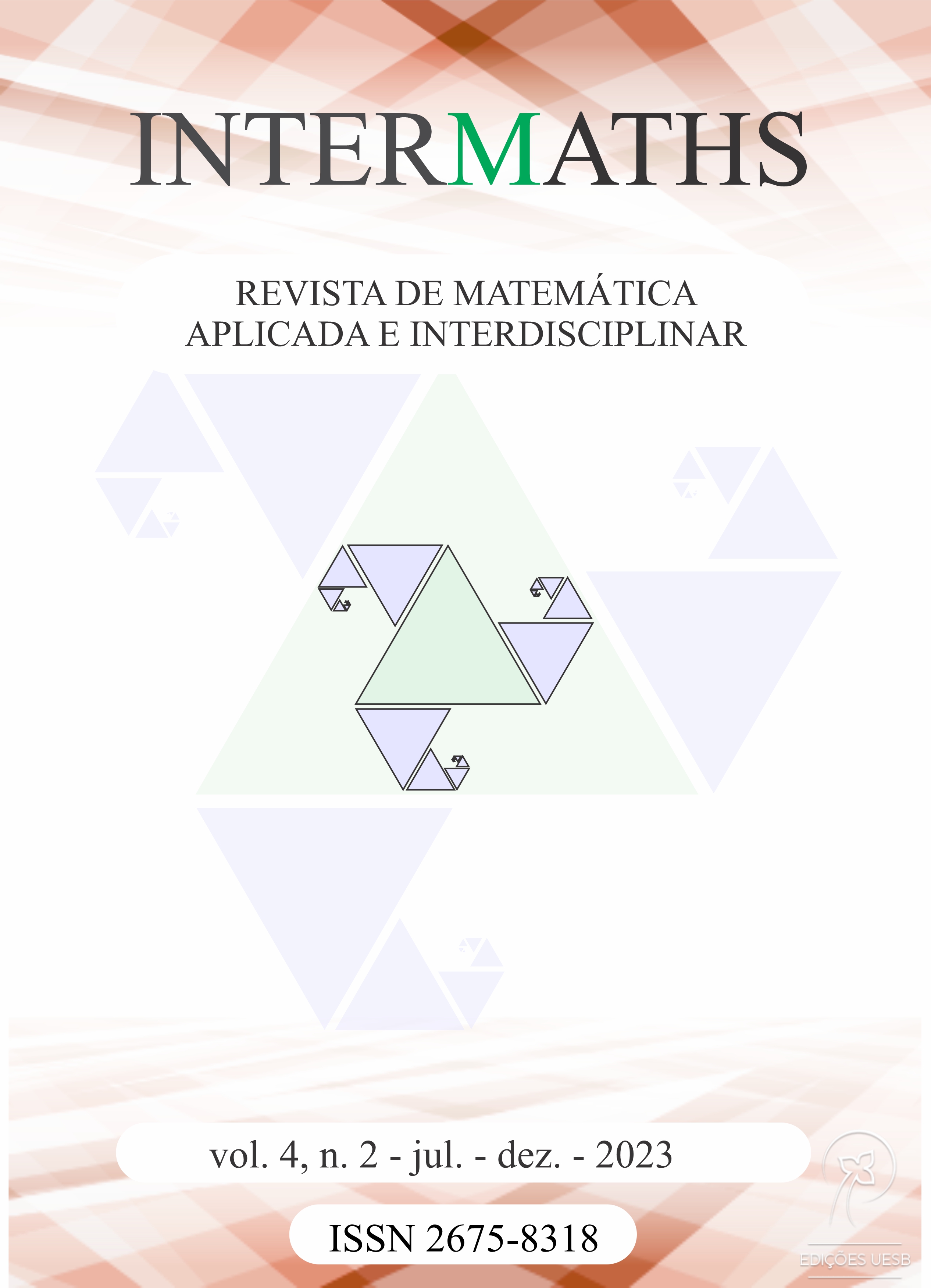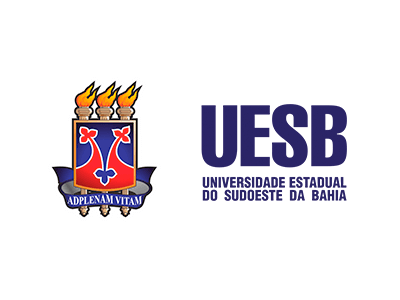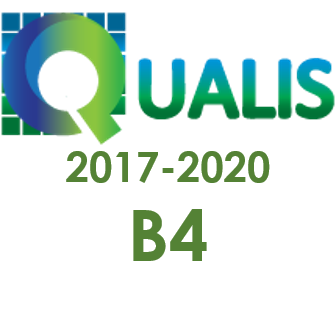Elementos básicos de aprendizagem de máquina
DOI:
https://doi.org/10.22481/intermaths.v4i2.13422Palavras-chave:
Aprendizagem de Máquina (ML)., Inteligência Artificial (IA), Mineração de Dados Educacionais (EDM), Previsão de Abandono Escolar, Redes Neurais (RN)Resumo
Neste trabalho realizamos a revisão de seis artigos científicos sobre a evasão escolar que utilizaram Aprendizagem de Máquina como metodologia para detectar as possíveis causas. A metodologia utilizada por esta pesquisa é a bibliográfica, pois investigou-se quais são os temas e elementos técnicos de cada um dos artigos, principalmente em relação a aprendizagem de máquina. Os resultados obtidos são sobre os principais elementos que estruturam os algoritmos de aprendizagem de máquina a partir dos seis artigos científicos estudados. O tema é muito abrangente e envolve diversas áreas e subáreas do conhecimento científico, como por exemplo Álgebra Linear, Matrizes, Teoria da Computação, Computabilidade, Modelos de Computação, Linguagem Formais e Autômatos, Análise de Algoritmos e Complexidade Computacional. As Técnicas de Mineração de Dados (EDM) são as ações utilizadas para encontrar padrões em um grande volume de dados. Estes padrões podem ser explicativos, de modo a descrever as relações entre segmentos de dados, ou preditivos, os quais podem prever valores futuros baseados em dados anteriores. Ao final, o leitor terá uma visão ampla de como ocorre todo o processo metodológico de produção e construção de aprendizagem de máquina.
Downloads
Metrics
Referências
DEL BONIFRO, Francesca et al. Student dropout prediction. In: Artificial Intelligence in Education: 21st International Conference, AIED 2020, Ifrane, Morocco, July 6–10, 2020, Proceedings, Part I 21. Springer International Publishing, 2020. p. 129-140.
YU, Renzhe; LEE, Hansol; KIZILCEC, René F. Should college dropout prediction models include protected attributes?. In: Proceedings of the eighth ACM conference on learning@ scale. 2021. p. 91-100.
COSTA, Stella F.; DINIZ, Michael M. Application of logistic regression to predict the failure of students in subjects of a mathematics undergraduate course. Education and Information Technologies, v. 27, n. 9, p. 12381-12397, 2022.
MÁRQUEZ‐VERA, Carlos et al. Early dropout prediction using data mining: a case study with high school students. Expert Systems, v. 33, n. 1, p. 107-124, 2016.
KARIMI-HAGHIGHI, Marzieh; CASTILLO, Carlos; HERNÁNDEZ-LEO, Davinia. A causal inference study on the effects of first year workload on the dropout rate of undergraduates. In: International Conference on Artificial Intelligence in Education. Cham: Springer International Publishing, 2022. p. 15-27.
KOTSIANTIS, Sotiris B.; PIERRAKEAS, C. J.; PINTELAS, Panayiotis E. Preventing student dropout in distance learning using machine learning techniques. In: Knowledge-Based Intelligent Information and Engineering Systems: 7th International Conference, KES 2003, Oxford, UK, September 2003. Proceedings, Part II 7. Springer Berlin Heidelberg, 2003. p. 267-274.
CHANG, Chih-Chung; LIN, Chih-Jen. LIBSVM: a library for support vector machines. ACM transactions on intelligent systems and technology (TIST), v. 2, n. 3, p. 1-27, 2011.
BREIMAN, Leo. Bagging predictors. Machine learning, v. 24, p. 123-140, 1996.
MUSCHELLI III, John. ROC and AUC with a binary predictor: a potentially misleading metric. Journal of classification, v. 37, n. 3, p. 696-708, 2020.
KOIZUMI, Yuma et al. SNIPER: Few-shot learning for anomaly detection to minimize false-negative rate with ensured true-positive rate. In: ICASSP 2019-2019 IEEE International Conference on Acoustics, Speech and Signal Processing (ICASSP). IEEE, 2019. p. 915-919.
MURTHY, Sreerama K. Automatic construction of decision trees from data: A multi-disciplinary survey. Data mining and knowledge discovery, v. 2, p. 345-389, 1998.
MITCHELL, Tom M. Machine learning. 1997.
DOMINGOS, Pedro; PAZZANI, Michael. On the optimality of the simple Bayesian classifier under zero-one loss. Machine learning, v. 29, p. 103-130, 1997.
AHA, D. Lazy Learning. Kluwer Academic Publishers. 1997.
SCOTT LONG, John. Regression models for categorical and limited dependent variables. Advanced quantitative techniques in the social sciences, v. 7, 1997.
BURGES, Christopher J C. A tutorial on support vector machines for pattern recognition. Data mining and knowledge discovery, v. 2, n. 2, p. 121-167, 1998.
POWERS, David MW. Evaluation: from precision, recall and F-measure to ROC, informedness, markedness and correlation. arXiv preprint arXiv:2010.16061, 2020.
FREEMAN, Elizabeth A.; MOISEN, Gretchen G. A comparison of the performance of threshold criteria for binary classification in terms of predicted prevalence and kappa. Ecological modelling, v. 217, n. 1-2, p. 48-58, 2008.
LÓPEZ, Victoria et al. An insight into classification with imbalanced data: Empirical results and current trends on using data intrinsic characteristics. Information sciences, v. 250, p. 113-141, 2013.
BRADLEY, Andrew P. The use of the area under the ROC curve in the evaluation of machine learning algorithms. Pattern recognition, v. 30, n. 7, p. 1145-1159, 1997.
SPACKMAN, Kent A. Signal detection theory: Valuable tools for evaluating inductive learning. In: Proceedings of the sixth international workshop on Machine learning. Morgan Kaufmann, 1989. p. 160-163.
HOSMER, D. W.; LEMESHOW, Stanley. John Wiley & Sons. New York, 2000.
ROSENBAUM, Paul R.; RUBIN, Donald B. The central role of the propensity score in observational studies for causal effects. Biometrika, v. 70, n. 1, p. 41-55, 1983.
BRAY, Bethany C. et al. Inverse propensity score weighting with a latent class exposure: Estimating the causal effect of reported reasons for alcohol use on problem alcohol use 16 years later. Prevention Science, v. 20, p. 394-406, 2019.
GLYNN, Adam N.; QUINN, Kevin M. An introduction to the augmented inverse propensity weighted estimator. Political analysis, v. 18, n. 1, p. 36-56, 2010.
VARELLA, Carlos Alberto Alves. Análise multivariada aplicada as ciências agrárias. Seropédica: Universidade Federal Rural do Rio de Janeiro, 2008.
ASSUNÇÃO, R. Linear Discriminant Analysis. Minas Gerais: DCC-UFMG, 2020.
MENOTTI, D. Classificação. Universidade Federal do Paraná (UFPR). Especialização em Engenharia Industrial 4.0. Paraná.
Publicado
Como Citar
Edição
Seção
Licença
Copyright (c) 2023 INTERMATHS

Este trabalho está licenciado sob uma licença Creative Commons Attribution 4.0 International License.
 All content of Revista INTERMATHS/Journal INTERMATHS is licensed under a Creative Commons - Atribuição 4.0 Internacional (CC-BY 4.0).
All content of Revista INTERMATHS/Journal INTERMATHS is licensed under a Creative Commons - Atribuição 4.0 Internacional (CC-BY 4.0).







